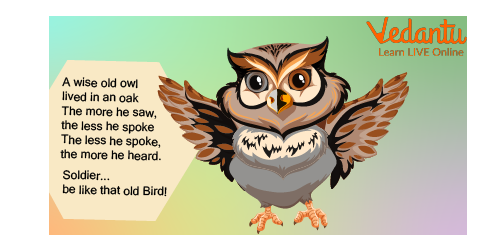Introduction of “A Wise Old Owl”
The nursery rhyme "A Wise Old Owl" was created in the USA. Although we are unsure of its precise roots, it most likely dates to the 19th century. John D. Rockefeller brought it up for the first time at the start of the 20th century.
In this nursery rhyme, the owl is interpreted as a representation of wisdom. Children can learn this rhyme quite easily, and it works well for teaching them the value of silence. This poem, during World War II used by American soldiers to show that silence means security.
The four-line poem "A Wise Old Owl," whose origin is unknown, has been mentioned in literature since 1883. A source from 1904 (below) gives credit for this poem to Bromley, an immortal poet.

Owl
“A Wise Old Owl” Poem Lyrics
A wise old owl lived in an oak
The more he saw, the less he spoke
The less he spoke, the more he heard.
Why can’t we all be like that wise old bird?

A Wise Old Owl Poem
Owl as a Poet’s Choice
The owl has become the ideal subject for poets and poems because of its nocturnal habit, distinctive look, and association with legends and folklore. Some famous poets that write poetry about owls are Kobayashi Issa, Alan Watts and Emily Dickinson, who are influenced by owls today.

Unknown Poet of the "A Wise Old Owl" Poem
An Industrialist and a Poem
John D. Rockefeller, a billionaire who lived from July 8, 1839, to May 23, 1937, is still considered to be one of the wealthiest people in history. In 1870, he emerged from humble beginnings to form Standard Oil. He then brutally set out to eliminate his rivals in order to monopolise the oil business. He expanded into related industries like iron, steel, and copper, as well as railroads, corner stores, and newspapers. He clashed with the American government, which created the Sherman Antitrust Act in 1890 to break up Standard Oil. This led to a protracted legal dispute, which the government ultimately won in 1911.
In 1896, Rockefeller retired, handing the reins of his business to his lone son, and began a second career as a philanthropist. Owl's poem gained popularity after John D. Rockefeller quotes the lines of this poem.

John D. Rockefeller
Fun Fact about Owl
An owl's eyes are not its actual "eyeballs." As a result of their tube-shaped eyes' complete immobility, they have binocular vision that allows them to fully focus on their prey and improve depth perception.
The ears of many owl species are asymmetrical. The ears of owls can locate sounds in many dimensions when positioned at various heights on their heads. Get set, aim, and strike.
A parliament is a collection of owls. This is based on a passage in The Chronicles of Narnia by C.S. Lewis about an owl gathering.
Owls have a 270-degree neck rotation. When neck movement cuts off circulation, a blood-pooling system gathers blood to fuel their brains and eyes.
The owls hunt each other. The largest predator of the lesser Barred Owl is the Great Horned Owl.

Fact about an Owl
Summary
A wise old owl is a poem that tells about the wisdom of an owl. In this poem owl is depicted as a wise bird and also earlier humans see owl as a symbol of wisdom, owl is a nocturnal bird, which you can easily see around yourself.


FAQs on A Wise Old Owl
1. Write about one poet who writes poems on animals?
English author Rudyard Kipling has high regard for all animals. The Jungle Book, a tale of Mowgli, a small boy who grows up in the jungle and learns from the animals, is undoubtedly the work for which he is most well-known. Who hasn't seen the well-known animated film? Numerous poems were written by Kipling, who also penned animal themes. He also wrote about foxes, huge cats, snakes, flies, bees, and cuckoo bi.
2. Why was the owl depicted as a wise bird?
Given their keen senses and connection to the night, owls are revered as knowledgeable animals. The Ancient Greeks were particularly struck by the owl's night vision, which they attributed to a mysterious inner light and connected to Athena, the Goddess of Wisdom. In reality, No less intelligent than the majority of other wild birds are owls. Although they can use tools, they are unable to perform well on cognitive examinations. In a test, grey owls were unable to grasp how to pull a thread that would bring a treat their way, unlike burrowing owls that can utilise poo to attract dung beetles.





